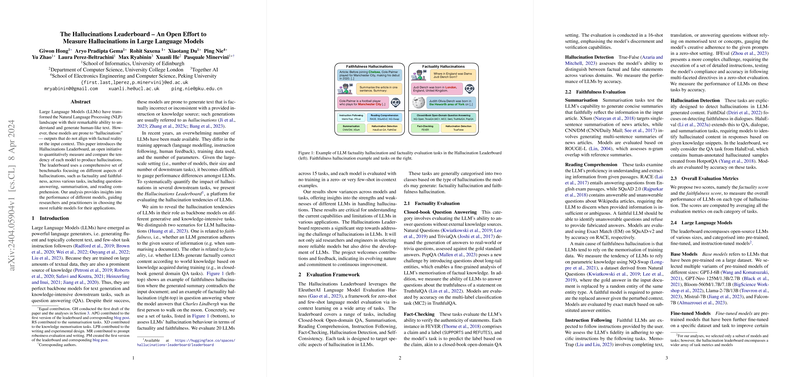The Hallucinations Leaderboard: Evaluating Hallucination Tendencies in LLMs
The proliferation of LLMs has fundamentally altered the landscape of NLP with their capabilities for language generation and few-shot learning. However, these models are prone to generating outputs that may not align with factuality or the provided context, a phenomenon termed "hallucinations." The paper "The Hallucinations Leaderboard — An Open Effort to Measure Hallucinations in LLMs" introduces a platform aimed at addressing this issue through the evaluation of LLMs' hallucination tendencies. This essay provides a comprehensive evaluation of the paper, highlighting its methodologies, findings, and implications for future AI research.
Motivation and Framework
The motivation for developing the Hallucinations Leaderboard arises from the challenges imposed by hallucinations in LLMs, which pose significant limitations on their reliability across various applications. The paper identifies two primary forms of hallucinations: factuality and faithfulness. Factuality refers to the correctness of the information produced by LLMs, whereas faithfulness pertains to the model's adherence to the given source context.
To evaluate these dimensions, the authors employ a diverse set of tasks categorized into factuality and faithfulness. The evaluation framework leverages the EleutherAI LLM Evaluation Harness, ensuring a structured approach to in-context learning via zero-shot and few-shot scenarios.
Analysis and Results
The analysis conducted in the paper evaluates 20 LLMs across 15 tasks, aimed at gauging factuality and faithfulness in a range of applications such as question answering, summarization, and reading comprehension. Interestingly, the results indicate variance across different models and tasks. A key observation is that LLMs exhibit better capabilities in evaluating factuality and faithfulness internally than in generating factually and contextually accurate responses.
The paper also explores the effects of model scale and fine-tuning. Larger models tend to perform better in factuality tasks, corroborated by a notable increase in scores with increasing model size. Moreover, the research shows that instruction fine-tuning generally improves faithfulness, enhancing the models' capability to adhere to contexts, although this does not always translate into improved factuality.
Implications and Future Directions
The Hallucinations Leaderboard provides an instrumental platform for understanding and mitigating hallucination tendencies in LLMs. This initiative holds significant implications for enhancing the reliability and efficacy of LLMs in real-world applications, facilitating the selection of more reliable models by researchers and practitioners. Moreover, the paper advocates for community contributions to the evolving leaderboard, suggesting potential paths for continuous improvement.
The paper opens several avenues for future research. One area of investigation could involve further exploring the trade-offs between instruction fine-tuning and factuality improvements. The influence of prompt templates and shot examples on hallucination tendencies also merits deeper exploration. Additionally, extending the scope of evaluated models to include proprietary black-box models like GPT-4 could provide a more robust comparison of LLM tendencies.
Conclusion
In conclusion, the Hallucinations Leaderboard represents a critical step toward addressing the hallucination challenges in LLMs. Through comprehensive evaluation and collective insights, it paves the way for enhanced LLM development and application, fostering advancements in NLP while highlighting the importance of community-driven efforts in AI research. As the landscape of AI continues to evolve, tools such as the Hallucinations Leaderboard will be invaluable in ensuring that LLMs are equipped to navigate complex, real-world scenarios with greater factual and contextual fidelity.
